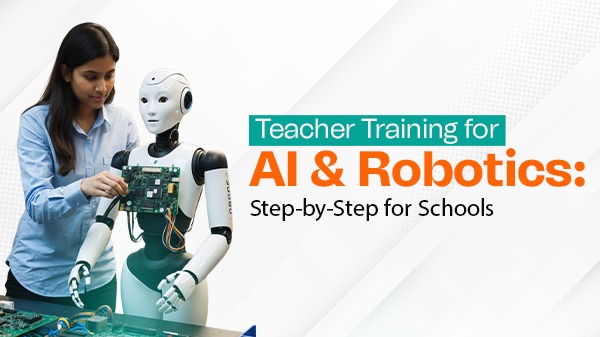
Schools are witnessing the revolution of this decade. Artificial intelligence (AI) and robotics are no longer some future-expected integrations in education. With the latest education policy (NEP 2020) making ICT, coding, and digital literacy integral parts of education, all schools are, at the very least, aware of the significance of AI and robotics. However, almost all schools are missing one key aspect of this integration (your school may be making this mistake as well), namely, teacher training. The success of any AI or robotics curriculum depends on well-trained teachers who can confidently deliver it (yet most people overlook it). If your school is looking to excel in this new integration, this guide provides a step-by-step roadmap for implementing teacher training in AI and Robotics.
How To Implement AI In Classroom (And Robotics with teachers!)
Step 1: Assess Your School’s Current Readiness
Consider this as choosing your “level”; the catch is that your past decisions have already determined your level. Conduct a school-wide survey that answers these questions:
- Do your teachers have a background in computer science or ICT?
- Does your school host infra like devices, labs, robotics kits, and internet connectivity?
- Which tech-related concept are your teachers most hesitant about?
A simple email or circular sent across the faculty would easily provide you with the necessary information.
Step 2: Choosing The Right Training Partner
The journey can get easy if you have an expert by your side. A training partner can adapt its efforts to your “level;” look for if they suffice this:
- NEP-aligned curriculum: Ensure that the training revolves around AI, coding, robotics, and ICT teacher training NEP 2020 prescribes.
- Practicality: AI and robotics training can’t just be about books. The program should include practicing with robotics kits, AI tools, and classroom simulations.
- Continuous Support: A one-time session isn’t training; ensure the partner is up for ongoing mentorship and refresher sessions.
- Contextual Relevance: Programs should focus on classroom implementation, rather than just abstract concepts.
Step 3: Integrate With NEP 2020 & ICT Guidelines
Eventually, every school must adhere strictly to the NEP 2020, as released by the relevant educational body. NEP 2020 and your school’s AI-Robo integration don’t stand individually, but rather together. Here’s what your robotics and AI curriculum training for teachers should follow:
- Teacher training modules with the exact characteristics highlighted by the ICT guidelines.
- Include digital pedagogy skills so your teachers can get comfortable with the blended learning model.
- Ensure that robotics and AI programs incorporate coding literacy, problem-solving skills, and design thinking.
Step 4: Launch Pilot Programs In Classrooms
Rather than completely changing how you teach, start small.
- Introduce a school robotics training program for mid-graders.
- Empower teachers to integrate AI/robotics curriculum with other subjects.
- Reward problem-solving—doesn’t matter if they fail; the point is about getting back up.
Step 5: Scale & Sustain The Training
It doesn’t end when you have successfully integrated the curriculum. The key is to sustain with improved efforts and long-term success.
- Once you observe a successful pilot, move towards full curriculum integration.
- Provide your teachers with AI-based teaching tools, online resources, and lesson plan banks.
- Utilize teacher feedback to enhance current practices.
- Foster a friendly, competitive nature—reward teachers who innovate with AI and robotics in the classroom.
Common Challenges (And How To Overcome Them)
- Teacher Resistance – Make them comfortable with continuous learning and help them understand the time-saving benefits.
- Budget Constraints – Don’t go all out; adopt a phased approach, and explore CSR or EdTech partnerships.
- Unclear Curriculum – Strictly follow the path laid down by the CBSE in the New Education Policy (NEP) 2020.
Conclusion
AI and robotics are going to change the educational landscape, of course. However, the key to a smooth integration of these technologies in the curriculum is teacher training. Schools should prioritize teacher training and ensure a smooth integration. Schools that invest in teacher training for AI & Robotics don’t just meet compliance; they become future-ready institutions that parents trust.

